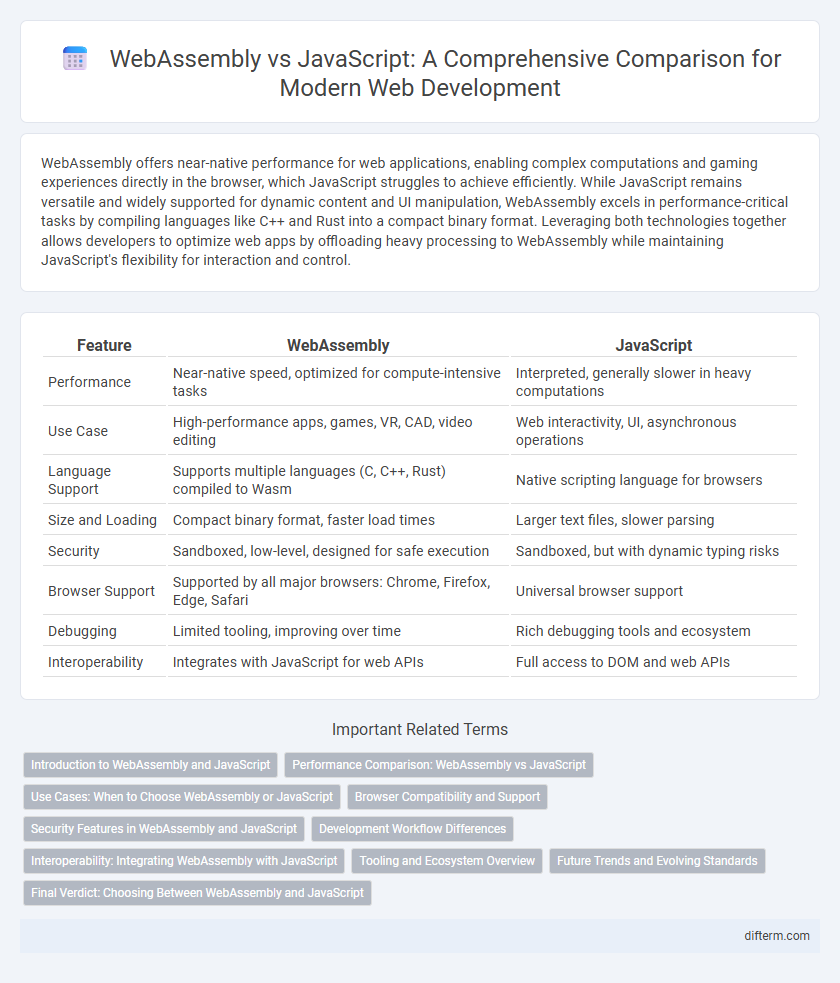WebAssembly offers near-native performance for web applications, enabling complex computations and gaming experiences directly in the browser, which JavaScript struggles to achieve efficiently. While JavaScript remains versatile and widely supported for dynamic content and UI manipulation, WebAssembly excels in performance-critical tasks by compiling languages like C++ and Rust into a compact binary format. Leveraging both technologies together allows developers to optimize web apps by offloading heavy processing to WebAssembly while maintaining JavaScript's flexibility for interaction and control.
Table of Comparison
| Feature | WebAssembly | JavaScript |
|---|---|---|
| Performance | Near-native speed, optimized for compute-intensive tasks | Interpreted, generally slower in heavy computations |
| Use Case | High-performance apps, games, VR, CAD, video editing | Web interactivity, UI, asynchronous operations |
| Language Support | Supports multiple languages (C, C++, Rust) compiled to Wasm | Native scripting language for browsers |
| Size and Loading | Compact binary format, faster load times | Larger text files, slower parsing |
| Security | Sandboxed, low-level, designed for safe execution | Sandboxed, but with dynamic typing risks |
| Browser Support | Supported by all major browsers: Chrome, Firefox, Edge, Safari | Universal browser support |
| Debugging | Limited tooling, improving over time | Rich debugging tools and ecosystem |
| Interoperability | Integrates with JavaScript for web APIs | Full access to DOM and web APIs |
Introduction to WebAssembly and JavaScript
WebAssembly is a low-level binary instruction format designed for efficient execution and compact representation, enabling near-native performance in web applications. JavaScript, a high-level, interpreted scripting language, remains the foundational language for dynamic web content and browser interaction. WebAssembly complements JavaScript by executing performance-critical code while JavaScript handles application logic and user interface manipulation.
Performance Comparison: WebAssembly vs JavaScript
WebAssembly delivers near-native performance by leveraging low-level binary code execution, outperforming JavaScript in compute-intensive tasks such as image processing, gaming, and cryptography. JavaScript, while versatile and widely supported, relies on Just-In-Time (JIT) compilation, which introduces overhead that can slow performance in heavy computational scenarios. Benchmark tests reveal WebAssembly's superior speed and efficiency, making it the preferred choice for performance-critical web applications.
Use Cases: When to Choose WebAssembly or JavaScript
WebAssembly excels in performance-critical applications such as gaming, video editing, and scientific simulations where near-native speed is essential. JavaScript remains the preferred choice for web development involving DOM manipulation, UI interactivity, and rapid prototyping due to its flexibility and extensive ecosystem. Choosing between WebAssembly and JavaScript depends on balancing performance needs against development speed and compatibility with existing web technologies.
Browser Compatibility and Support
WebAssembly offers near-universal browser compatibility with major browsers like Chrome, Firefox, Safari, and Edge supporting it natively, ensuring high-performance execution for complex applications. JavaScript remains fully supported across all browsers and their versions due to its long-established role as the standard scripting language for the web. Developers often combine WebAssembly with JavaScript to optimize performance-critical parts while maintaining broad compatibility and comprehensive API support.
Security Features in WebAssembly and JavaScript
WebAssembly offers enhanced security features through its sandboxed execution environment, which isolates code from the host system, reducing risks of vulnerabilities commonly exploited in JavaScript. While JavaScript relies on browser security models such as Same-Origin Policy and Content Security Policy, WebAssembly's strict validation and structured control flow enable safer execution of low-level code. This built-in isolation minimizes attack surfaces and mitigates threats like buffer overflow or code injection that are more prevalent in JavaScript environments.
Development Workflow Differences
WebAssembly offers a low-level binary format that enables faster execution and closer-to-native performance compared to JavaScript, which is an interpreted high-level language. The development workflow for WebAssembly involves compiling code from languages like C, C++, or Rust into a compact binary, while JavaScript development relies on direct scripting within web browsers or Node.js environments. Debugging and tooling for WebAssembly are more complex due to its compilation step, whereas JavaScript benefits from mature ecosystems and immediate code execution.
Interoperability: Integrating WebAssembly with JavaScript
WebAssembly seamlessly integrates with JavaScript through a shared linear memory and JavaScript APIs, enabling efficient communication between the two. Developers can invoke WebAssembly modules within JavaScript environments, leveraging the strengths of both to optimize execution and performance in web applications. This interoperability supports complex functionalities like real-time graphics and computation-intensive tasks while maintaining JavaScript's flexibility and ease of use.
Tooling and Ecosystem Overview
WebAssembly offers robust tooling support with languages like Rust, C++, and Go compiling directly into it, enabling near-native performance in web applications. JavaScript benefits from a mature ecosystem with extensive libraries, frameworks, and developer tools, facilitating rapid development and debugging. Combining WebAssembly modules with JavaScript allows developers to leverage optimized performance while maintaining the flexibility of JavaScript's vibrant ecosystem.
Future Trends and Evolving Standards
WebAssembly is rapidly gaining traction as future trends emphasize high-performance web applications and low-level system capabilities beyond JavaScript's traditional scope. Emerging standards such as WebAssembly's interface types and multi-threading support are expanding its use cases, positioning it as a complement rather than a replacement for JavaScript. Ongoing collaboration between browser vendors and standards bodies ensures continuous evolution, enabling seamless integration of WebAssembly modules alongside JavaScript to meet the demands of modern web development.
Final Verdict: Choosing Between WebAssembly and JavaScript
WebAssembly offers near-native performance ideal for compute-intensive applications, while JavaScript provides unmatched flexibility and ease of use for web development. Developers should consider WebAssembly for performance-critical modules and maintain JavaScript for overall interface and logic to optimize both speed and functionality. The final choice depends on the specific project requirements, balancing execution efficiency with development agility.
WebAssembly vs JavaScript Infographic

 difterm.com
difterm.com